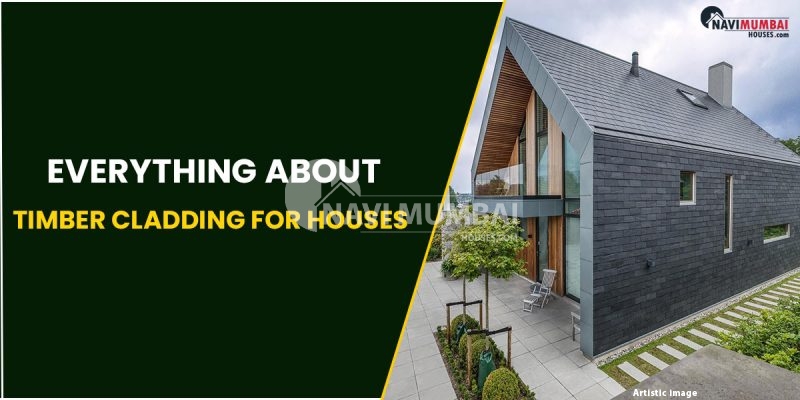Timber Cladding For Houses- It is important to seek advice from experts and take into account the climate in your area when selecting wood siding for your residences. Wooden siding is akin to receiving a comforting embrace from the natural world. It gives your space a timeless air that makes it feel cosy and welcoming. Not only does timber cladding look good, but it also protects your house from the elements and conserves energy by maintaining a suitable interior temperature. In this post, we’ll discuss the benefits of timber cladding, the various varieties available, and installation techniques to bring that extra warm touch to your house.
Are you searching upcoming project in vashi?
What is timber cladding?
Timber cladding, sometimes referred to as weatherboarding or wood siding, is similar to adding a wooden jacket to the exterior walls of your house. It is attached to the exterior of your home and is constructed from interlocking planks or boards. Timber cladding serves two primary purposes:
First of all, it looks great in your house! It lends your home a homely, natural feel that complements a variety of architectural styles, including modern and traditional cabins. Also serves as a barrier for your home. It helps to keep your home safe & in good condition by keeping the sun, rain, wind, and even little strikes away from your walls. Therefore, installing timber cladding does more for your home’s appearance than merely improving its appearance.
Functions of Timber Cladding
Creating an amazing look for your house
Timber cladding gives your house a unique look and feels quite comfortable. The wood’s organic patterns add interest to your home’s appearance and a touch of nature within.
Your home can be customised to look precisely how you want it to by choosing from a wide variety of wood species, stains, and finishes. Timber cladding is a great option if you want a sharper, more contemporary look or a classic, cosy look.
Keeping your house safe
Not only does timber cladding look good, but it’s also durable! It functions as a shield, shielding your house from inclement weather, including wind and rain, as well as intense sunshine. When installed properly, it can also aid in maintaining a comfortable interior temperature in your house. This implies that it can assist in keeping you warm in the winter and cool in the summer. Additionally, it can reduce outside noise, which will quiet your house. Therefore, installing timber cladding adds value to your home while also keeping it secure and comfortable.
Types of timber cladding
By the woods
Softwoods
They are inexpensive, strong, and simple to deal with, which is why they are so popular for cladding. These are a few typical kinds:
Western red cedar: People adore this variety for its natural beauty, long lifespan free from decay, and low maintenance requirements.
Siberian larch: This wood is initially cold reddish-brown, but it eventually turns silver-grey. It appears amazing and is strong.
Douglas fir: This timber is inexpensive and readily available. It also withstands weathering effectively.
Thermally modified softwoods: These trees are heated to increase their strength and stability. Thermo-ash and Thermo-pine are two examples.
Hardwoods
These woods cost more, but they last longer and add a luxurious feel to your house. These are a few choices:
European oak: With its cool grain patterns, this wood has a beautiful appearance and is incredibly robust. It requires a little more maintenance than softwoods.
Tropical hardwoods: These woods have a wide range of colours and textures and are incredibly durable. However, one should consider the potential environmental impact of taking them down.
By profile
Shiplap: These planks fit tightly together to create a tight seal against the elements because they feature a ridge on one edge and a groove on the other.
Board on board: For a traditional appearance, install basic flat boards with a modest space between them.
Featheredge: To create a waterproof barrier, the tapering edge of these boards overlaps the one below it. They’re frequently picked out for their rustic look.
V-Groove: These boards feature a sleek, contemporary design thanks to a V-shaped groove running the length of them.
Shadow gap: A clear shadow line is produced by a larger space between the boards than in a board-on-board situation.
The advantages of timber cladding
Looks great: The organic attractiveness of timber cladding gives buildings a warm, inviting appearance.
Keeps things comfy: It makes places cosier by keeping buildings quiet and warm during the winter.
Stands the test of time: Timber cladding can remain beautiful and long-lasting for a long time with proper maintenance.
Easy to put up: Because it is lightweight and simple to use, installation is a snap.
Good for the Planet: By promoting the use of renewable resources, using wood from sustainable sources benefits the environment.
Not a hassle to maintain: Timber cladding usually doesn’t take much effort to stay in good condition, although it does require occasional maintenance.
Lots of Choices: You can choose the ideal appearance for your building from a plethora of colour and finish options.
Adds value: A property’s worth may rise if timber cladding increases the property’s appeal to potential buyers.
Feels like home: The comfortable ambiance that woods provide envelops us and helps us feel attuned to nature.
Timber cladding installation
Measure carefully: When measuring the space to be covered by cladding, be sure to take precise measurements. To prevent issues later on, precision is essential.
Order the right amount: Place the appropriate quantity of wood in your order based on your dimensions.
Select a wood species that is appropriate for your climate:
Pine and other softwoods are inexpensive and simple to deal with.
Hardwoods with distinctive grain patterns and higher durability, such as Ash, Oak, or Iroko, come at a higher cost.
Ordering extra supplies such as screws, reveals, and corner trim is important. Allow an additional 10% for errors and trimming.
Preparation the surface: Prior to installation, prepare the surface:
Thoroughly clean it to get rid of any debris or grime.
Even out any bumptious or inclines.
Cladding battens should be firmly fastened to the wall. Don’t forget to give them enough space:
Battens are usually placed 400 mm apart.
If counterbating, place horizontal battens 400 mm apart from vertical rows spaced 600 mm apart.
If you’re using fresh softwood, let it a few days to acclimatize to the surroundings and reduce warping.
You can start your timber cladding job off right with these easy steps.
You’re looking for Projects in Badlapur have the Best Properties In Thane Like Ready to Move:https://navimumbaihouses.com/properties/search/badlapur-/
If you want daily property update details please follow us on Facebook Page / YouTube Channel / Twitter
The post Everything About Timber Cladding For Houses appeared first on .

